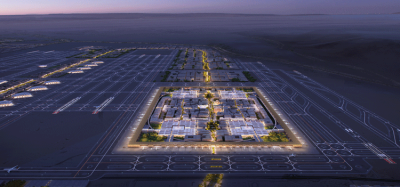Coping with the growth of the industry
- Like
- Digg
- Del
- Tumblr
- VKontakte
- Buffer
- Love This
- Odnoklassniki
- Meneame
- Blogger
- Amazon
- Yahoo Mail
- Gmail
- AOL
- Newsvine
- HackerNews
- Evernote
- MySpace
- Mail.ru
- Viadeo
- Line
- Comments
- Yummly
- SMS
- Viber
- Telegram
- Subscribe
- Skype
- Facebook Messenger
- Kakao
- LiveJournal
- Yammer
- Edgar
- Fintel
- Mix
- Instapaper
- Copy Link
Posted: 1 August 2008 | Dr. Ghanem Al-Hajri, Director General, Sharjah Airport Authority and Secretary General Gulf Airports Services Association | No comments yet
There has been an almost global trend to reduce the economic regulation of transportation markets. This has sometimes extended beyond the airline market and is gradually being seen in other components of the air transportation supply chain, such as airports and ground handlers.
The aviation industry is undoubtedly among the fastest growing in the world today, be it in terms of aircraft fleet, traffic growth or even revenues. Faster and wider aircrafts have appeared on the scene, allowing a much wider range of travellers capable of indulging in air travel. With liberal policies, travellers are offered more choice and variety in their mode of travel. Competitive pricing of services and the advent of low cost and no-frills airlines will be the order of the day.
In recent times, global liberalisation has had a dramatic impact on many facets of life, possibly most so on the world economy, with countries opening up their doors to free trade and commerce. This openness in trade is the automatic cause of better products and services being delivered at better prices, making the consumer the kingpin in the market.
An offshoot of this is that pressure is brought to bear on the ‘transporters’ and service providers to ensure that costs remain ‘reasonable’ and do not negatively affect the product price and service. All those who are connected with the transportation industry will have to innovate in order to accommodate the new trends. As such, it has become vital for every player in the industry to adapt to the new market demands, not only in terms of costs but also quality.
What are the expectations in defining ‘high service levels’ in today’s complex airline environment?
For the traditional airlines, the major differential between carriers has become the experience on the ground. Airline prices are all converging, given the transparency the internet brings to pricing; increasingly, everyone has a flat-bed, 300 channels of television and award winning food prepared by the latest celebrity chef.
The airport has become the real focal point of service levels with raised levels of security, LAG policies that vary from airport to airport, ever more complex immigration rules and larger aircraft increasing pressure points at peak times, all making a hassle free and pleasant airport environment an increasingly rare experience.
With the majority of airlines outsourcing their front line service staff to ground handling companies more often, it is the human element of the airport that is potentially one of the greatest service differentiators, as well as one of the greatest potential service failures. Airlines are putting this into the hands of their third party service providers around the world.
Working remotely, 24 hours a day in varied operating conditions for airlines, the target is achieving a level of consistency that means a passenger checking in today in New York and tomorrow in Sharjah will receive the same passenger experience, and consistently feel that the ‘airline cares and is willing to go the extra mile to satisfy you’.
This service consistency needs a level of skill to support it and as airlines look towards saving cost on their ground handling budget line; it is a constant juggle between this high level of service delivered consistently across the world and the cost of providing it.
On the cost side of ground handling, away from the traditional airlines the booming low cost industry has taken a different approach, simply focusing on how quickly and how cheaply an aircraft can be turned with minimal service requirements. Their opinion is that a cheap ticket and an on time departure is the true definition of high service.
To achieve the maximum efficiency of the largest cost of any ground handling company, which is the manpower cost, often the outsource partner may be checking in a full service airline at 2pm and the same staff checking in a low cost airline at 4pm. This flexibility to take a non-dedicated team of people that work to differing brand values, differing service priorities to different customers, all of which change flight by flight, shift by shift, is the true task of the ground handling providers in the passenger terminal today and in the future.
This increasingly complex pattern is mirrored in the cargo environment, with one flight containing perishable vegetables or live animals which are time sensitive, and the next aircraft containing transit cargo which has another aircraft waiting to pick it up, again the key is flexibility of people, highly trained to work to set procedures of multiple customers, all at a price that the airline is willing to pay.
Flexible, efficient and affordable, whether it is handling a three class A380, a MD11 freighter or a low cost A320, is the challenge facing every handling agency around the world.
The members of GASA are well aware of these demands and lay emphasis on key issues such as:
- Matters related to latest Information Technology in the sphere of Ground Handling
- Safety, Security and Assurance issues
- Continual Training regimes
- Challenges posed to Ground Handlers in the region
- Best practices, Service Level Agreements & benchmarking
GASA prides itself on maintaining close coordination with each other, through meetings, exchange of visits of different experts and professionals in different areas. Through such close networking, GASA ensures that every member is thoroughly aware of various matters affecting the industry, be it on the regional or international scene.
The exchange of information on issues such as equipment sourcing and evaluation, senior human resource, incidents and accidents and various other pertinent issues is constantly occurring within GASA, which keeps all members fully aware of the market situation. GASA works closely with related international bodies such as IATA as part of its overall objectives.
GASA has always availed itself of every opportunity to display its many advantages to potential users. It utilises forums such as expositions, conferences and seminars, as these events offer unique platforms for networking with key professionals in the industry. The exchange of ideas, expertise and sharing of experiences is always beneficial. There is the added likelihood of potential markets and keeping oneself updated with trends as well as officials in various partner organisations.
We have already seen the trend towards privatisation. The future will see ground handlers with a very cost-centric approach, i.e. efficiency and productivity driven and thereby raising service levels to new standards.
It is of vital importance that Local Licensing Authorities ensure that handling agencies maintain strict control. Implementation of systemised procedures and benchmark oriented documentation is what regulators would need to look at with minute attention.
The challenges will mainly be those of competition and increased service demands from the users, while at the same time managing to maintain its focus on commercial viability. With some of the privatised airports, we see competition not only from the vicinity of airports in the region, but also among the various handling companies in the same airport. Another major challenge facing ground handlers today is coping with the growth of the industry.
Whilst aircraft movements, passenger and freight traffic keep increasing dramatically and continually, ground handlers have great difficulties in getting the proportionate and requisite resources. Our industry is particularly hit by a lack of professional staff, and shortage of appropriate equipment.
Despite these challenges, it is important to establish an industry framework for performance measurement of service delivery standards that would enable the service providers to measure their performance/quality against standards agreed with their customers.
It is also vital to receive continuous feedback on key performance indicators, evaluate the same and ensure that systemised corrective measures are in place. This would help the handling company to lower costs, improve efficiency and enhance the performance levels with no additional manpower.
An honest appraisal entirely focused on uncovering weakness and building on strengths would allow for building and maintaining consistency in the short term, whilst providing a platform for continuous improvement in the longer term.

















